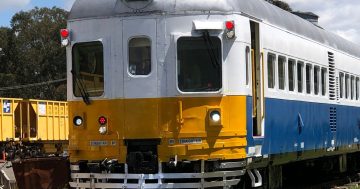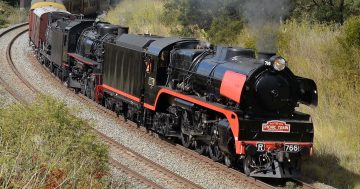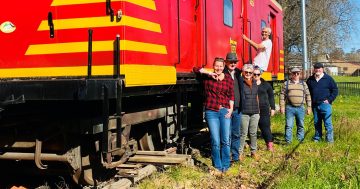
The Beyer-Garratt 6029 locomotive, City of Canberra, in action. It is not up for sale.
The auction next month of some of the Canberra Railway Museum’s assets, including 100-year-old carriages, is a key step in getting the beleaguered organisation back on track, according to the liquidator.
The museum closed last November with debts of $700,000 after the collapse of its ill-fated freight operation which had been designed to support its heritage trains program.
Deloitte’s Eddie Senatore said the Australian Railway Historical Society’s ACT division owed the Australian Taxation Office about $160,000 and employees about $60,000.
He said the auction was part of overall plans to restructure the organisation so that it can be financially viable and return to its core reason for being – running heritage trains, maintaining a museum, and providing a place for volunteers to be involved.
Mr Senatore said he was working with a range of parties – including the ACT Government, some private equity groups, the NSW Rail Museum and interested individuals – to find a way back for the museum.
He said none of the key pieces of the fleet would be up for sale when the auction takes place on site at Kingston on August 2.
He said some of the fleet, including the prized Beyer-Garratt 6029 locomotive, had been moved to the NSW Rail Museum at Thirlmere for safekeeping.
He denied the auction was a fire sale and refuted claims by some members of the Society, who have called for a public campaign to save the entire museum, that the carriages going under the hammer were of great historical significance to the ACT.
He said some of the carriages did carry troops but not necessarily from Canberra, while the Southern Aurora and steel carriages had no connection with the ACT.
He said the carriages that brought the early parliamentarians to Canberra were not being sold.
“What is being sold is not necessarily a ‘must have’ to bring the organisation back to running locomotives with an historical connection to the ACT,” he said.
“We’ve got all the small steam locos that aren’t up for sale at Kingston, so there are some really dilapidated carriages up for sale and it’s arguable that some of those have a historical connection to the ACT, but to the extent that you have $600,000 to $700,000 worth of creditors, the bottom line is you have to deal with them.
“We have to come up with a financial model that allows them to be operated in a financially robust way so that this situation doesn’t happen again.”
Mr Senatore said poor governance and a lack of financial oversight had led to the organisation growing beyond its means and running into major compliance issues, particularly with the scrap metal train to Botany Bay.
The cancelling of that contract was in dispute and the outcome may bring some return to the organisation.
He said it appeared that the heritage train ticket and charter prices had not reflected the expensive running costs of those trains.
He hopes that any resurrected organisation adopts a financial model that has been specially created to adequately price journeys.
“All you need to do in the model we’ve created is put ‘from, to’ and which locomotive and it should punch out the cost, and from there you can work out the price, and I can tell you its going to be more than $3 a person,” he said.
Mr Senatore said he hoped the auction raised interest from the train industry and lovers of trains.
“Private equity groups and individuals have approached us about how they can get involved with the Society, so we’re hoping that’ll happen. You can always stop an auction up until the day of the auction,” he said.
But Society member John Davenport believes the auction would be the thin edge of the wedge.
“These exhibits are doomed, so what is not being sold in this first auction is of great importance,” he said.
“If the liquidator decides to sell more of the collection, locomotive 6029, aka The City of Canberra, could be sold to a scrap metal merchant.”
A spokesman for Environment and Heritage Minister Mick Gentlemen said the ACT Government would not be intervening.
“The liquidator has a formal role to fulfil in managing the affairs of the organisation, and we need to allow that process to proceed. Many of the debts are commercially related and it is not the role of government to assume responsibility for commercial debts,” he said.
“We understand the liquidator is focused on retaining enough of a collection to enable a new organisation to be established and to continue sharing the history of rail in this region.
“The ACT Government will not be purchasing any rolling stock from the liquidation sale, but understands the historical significance these objects have to the Canberra region. As such, we have been working with the museum member representatives and the liquidator to identify the best way to support such a new organisation.”
The auction will take place at 10 am and the catalogue can be viewed here.
Should the Government step in to stop the auction and come up with a rescue package?
















